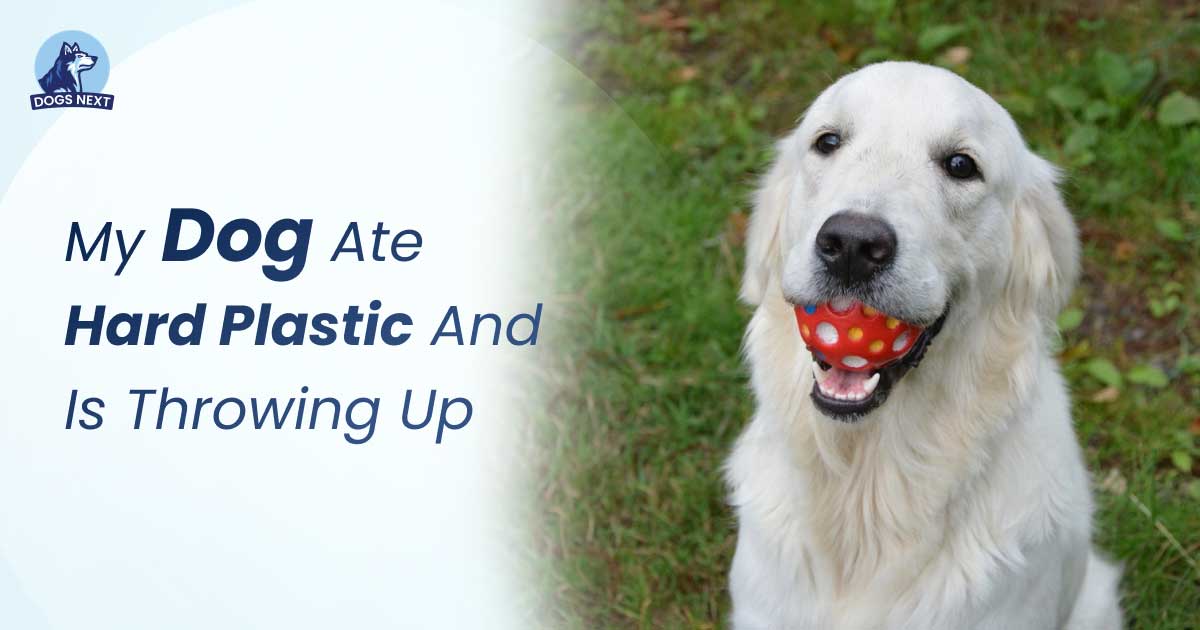If your dog ate hard plastic and is throwing up, seek immediate veterinary attention. Ingesting plastic can be dangerous for dogs, causing blockages in their digestive system.
Vomiting is a common sign of distress and should not be ignored. When a dog ingests hard plastic, it can lead to serious health complications. The sharp edges of the plastic can cause damage to the gastrointestinal tract, leading to pain, vomiting, and potential blockages.
It is crucial to have your dog examined by a veterinarian to determine the best course of action. Prompt treatment can prevent further complications and ensure your dog’s well-being. Remember, always keep small objects and potential hazards out of reach of your pets to avoid such emergencies.
Understanding The Situation
Dogs are curious creatures and sometimes, they eat things they shouldn’t. If your dog ate hard plastic and is throwing up, understanding the situation is crucial. Hard plastic can pose serious health risks to your furry friend. This blog post will help you understand why dogs eat hard plastic and the immediate dangers involved.
Possible Reasons For Eating Hard Plastic
There are several reasons why your dog might eat hard plastic. Understanding these reasons can help prevent future incidents.
- Curiosity: Dogs explore the world with their mouths. They might chew on plastic out of curiosity.
- Teething: Puppies go through a teething phase. They chew on hard objects to soothe their gums.
- Hunger: A hungry dog might eat non-food items if they can’t find anything else to eat.
- Boredom: Dogs need mental and physical stimulation. A bored dog might chew on hard plastic to pass the time.
- Anxiety: Some dogs chew on objects when they are anxious. This can be a coping mechanism.
Here is a table summarizing the possible reasons:
| Reason | Description |
| Curiosity | Exploring the world with their mouths |
| Teething | Soothing gums during teething phase |
| Hunger | Eating non-food items due to hunger |
| Boredom | Chewing to pass time |
| Anxiety | Coping mechanism for anxiety |
Immediate Risks And Concerns
Eating hard plastic can pose several immediate risks to your dog’s health. Being aware of these risks can help you act quickly and seek veterinary care.
Choking: Hard plastic pieces can get stuck in your dog’s throat, causing choking. This can be life-threatening.
Intestinal Blockage: Swallowed plastic can cause an intestinal blockage. This prevents food and water from passing through, leading to serious complications.
Internal Injuries: Sharp pieces of plastic can cause internal injuries. These can lead to bleeding and infections.
Vomiting and Diarrhea: Your dog might vomit or have diarrhea as their body tries to expel the foreign object.
Here is a list of immediate concerns:
- Choking
- Intestinal Blockage
- Internal Injuries
- Vomiting and Diarrhea
Always monitor your dog closely if they have ingested hard plastic. Contact your veterinarian immediately if you notice any signs of distress.
Initial Steps To Take
If your dog ate hard plastic and is now throwing up, it’s crucial to act quickly. Taking the right steps can make a big difference in your dog’s recovery. Here are the initial steps to take to ensure your dog’s safety and well-being.
Assessing The Dog’s Condition
First, you need to assess your dog’s condition. Look for signs of distress or severe symptoms. Observe your dog closely for the following:
- Excessive Vomiting: Frequent vomiting can indicate that the plastic is causing an obstruction.
- Labored Breathing: Difficulty breathing can be a sign of a serious problem.
- Lethargy: If your dog seems unusually tired or unresponsive, it could be a sign of trouble.
- Pain or Discomfort: Whining, yelping, or avoiding touch could indicate pain.
If you notice any of these symptoms, contact your veterinarian immediately. Even if the symptoms are mild, it’s always best to err on the side of caution.
Take note of how much plastic your dog might have ingested. This information will be helpful for your vet. Also, try to identify the type of plastic if possible.
| Symptom | Severity Level |
| Excessive Vomiting | High |
| Labored Breathing | High |
| Lethargy | Moderate |
| Pain or Discomfort | Moderate to High |
Removing Any Remaining Plastic Pieces
Once you’ve assessed your dog’s condition, check for any remaining plastic pieces in their mouth or on their fur. Carefully open your dog’s mouth and look inside. Use a flashlight if necessary to get a better view.
Follow these steps:
- Stay Calm: Your dog can sense your anxiety, which can make the situation worse.
- Use Gloves: Wear gloves to protect yourself and your dog.
- Check the Mouth: Look for any visible pieces of plastic stuck in the teeth or throat.
- Remove Gently: If you see plastic, gently remove it with your fingers or tweezers.
If the plastic is lodged too deep or if your dog resists, don’t force it. Forcing could push the plastic further down. In such cases, it’s best to seek professional help from your vet.
After removing any visible plastic, monitor your dog closely. Keep an eye on their behavior, appetite, and bathroom habits. Any changes might indicate that the plastic has caused internal issues.
Providing your vet with as much information as possible will help them decide the best course of action. This could include X-rays, endoscopy, or even surgery if the situation is severe.
Taking these initial steps can help ensure your dog’s safety and expedite their recovery. Always prioritize your dog’s health and seek professional help when needed.
When To Contact A Veterinarian
When your dog eats hard plastic and starts throwing up, it’s a worrisome situation. Knowing when to contact a veterinarian is crucial. Timely intervention can prevent severe complications and ensure your dog’s safety. This section helps you understand the signs that require immediate medical attention, the information you need to provide to your vet, and the possible emergency procedures that might be necessary.
Symptoms Requiring Immediate Attention
Recognizing the symptoms that need urgent care can save your dog’s life. If your dog exhibits any of these signs, contact a veterinarian right away:
- Persistent vomiting: If your dog keeps throwing up, it may indicate a blockage or internal injury.
- Abdominal pain: Watch for signs like whining, restlessness, or a tense belly.
- Lethargy: If your dog appears unusually tired or weak, it could be a sign of distress.
- Loss of appetite: Refusing food may indicate a serious issue.
- Bloody stools or vomit: Blood is a clear sign of internal damage.
- Difficulty breathing: This can signal a severe obstruction or internal injury.
Monitor your dog’s behavior closely. Even if symptoms seem mild, it’s better to be safe and consult a veterinarian.
Information To Provide To The Vet
When you contact the veterinarian, having the right information ready is essential. This helps the vet assess the situation quickly and accurately. Be prepared to provide the following details:
- Time of ingestion: When did your dog eat the plastic?
- Type of plastic: Describe the object if possible (size, shape, material).
- Symptoms observed: List all symptoms, even if they seem minor.
- Previous medical history: Mention any existing health conditions or medications.
- Behavioral changes: Note any changes in activity, appetite, or behavior.
Providing accurate information helps the vet make a better diagnosis and decide on the appropriate treatment plan.
Possible Emergency Procedures
In some cases, emergency procedures may be necessary to remove the plastic and treat your dog. Here are a few potential interventions:
| Procedure | Description |
| Endoscopy | A non-surgical method where a flexible tube with a camera is used to locate and retrieve the plastic. |
| Surgery | If the plastic is large or causing a blockage, surgical removal may be required. |
| Inducing Vomiting | Sometimes, the vet may induce vomiting to expel the plastic, but this is only safe within a certain timeframe. |
| IV Fluids | Intravenous fluids may be administered to prevent dehydration and support recovery. |
The choice of procedure depends on the severity of the situation and your dog’s overall health. Quick action and professional care can make a significant difference in the outcome.
At-home Care
When your dog eats hard plastic and starts throwing up, it can be alarming. At-home care is essential to ensure their comfort and safety. This guide provides important steps to help your furry friend recover.
Monitoring For Additional Symptoms
After your dog ingests hard plastic, carefully monitor for additional symptoms. This helps in early detection of any complications. Here are some signs to watch out for:
- Lethargy: Your dog appears unusually tired or inactive.
- Loss of Appetite: Refuses to eat or drink.
- Abdominal Pain: Whines or shows discomfort when the belly is touched.
- Diarrhea: Frequent, loose, or watery stools.
- Bloody Vomit or Stools: Presence of blood indicates a serious issue.
If you notice any of these symptoms, contact your vet immediately. Keeping a log of symptoms can be helpful:
| Symptom | Time Noticed |
| Lethargy | 10:00 AM |
| Loss of Appetite | 12:00 PM |
Keeping The Dog Hydrated
Keeping your dog hydrated is crucial. Vomiting can lead to dehydration. Follow these steps to ensure your dog stays hydrated:
- Provide Fresh Water: Ensure there is always clean, fresh water available.
- Use Ice Cubes: If your dog refuses to drink, offer ice cubes to lick.
- Electrolyte Solutions: Consider giving electrolyte solutions like Pedialyte. Consult your vet for the correct dosage.
Signs of dehydration to watch for:
- Dry Gums: Check if the gums are dry or sticky.
- Loss of Skin Elasticity: Gently pinch the skin; it should bounce back quickly.
- Sunken Eyes: Eyes appear sunken or dry.
If you notice these signs, seek veterinary care immediately.
A comfortable resting area helps your dog recover faster. Follow these tips to create a cozy space:
- Quiet Environment: Choose a quiet spot away from noise and activity.
- Soft Bedding: Provide soft bedding to cushion their body.
- Temperature Control: Ensure the area is not too hot or cold.
- Limited Movement: Restrict their movement to prevent further injury.
Here’s a simple checklist for the resting area:
| Requirement | Completed |
| Quiet Environment | ✔ |
| Soft Bedding | ✔ |
| Temperature Control | ✔ |
| Limited Movement | ✔ |
Providing a calm and comfortable space can make a big difference in your dog’s recovery process.
Providing A Comfortable Resting Area
When your dog eats hard plastic and starts throwing up, it’s crucial to provide a comfortable resting area. A cozy spot can help your furry friend feel safe while recovering. Ensure the area is clean, quiet, and free from distractions. This will allow your dog to rest and heal more effectively.
Gastrointestinal Blockages
Hard plastic can cause gastrointestinal blockages in dogs. This can be very serious. Symptoms of blockages include:
- Vomiting
- Loss of appetite
- Lethargy
- Abdominal pain
If you notice these symptoms, take your dog to the vet immediately. A blockage can prevent food and water from passing through the digestive system. This can lead to severe dehydration and other complications.
Vets may use imaging tests like X-rays to diagnose the blockage. Treatment options include:
| Treatment | Description |
| Endoscopy | Non-invasive, uses a camera to remove the blockage. |
| Surgery | Invasive, removes the blockage directly. |
Providing a comfortable resting area is essential during recovery. It helps reduce stress, which can worsen symptoms.
Internal Injuries And Tears
Hard plastic can cause internal injuries and tears in your dog’s digestive tract. These injuries can be life-threatening. Symptoms to watch for include:
- Blood in vomit or stool
- Severe abdominal pain
- Difficulty breathing
These symptoms require immediate veterinary attention. The vet may perform surgery to repair the tears. Antibiotics may also be prescribed to prevent infection.
While your dog heals, a comfortable resting area is crucial. Soft bedding can help minimize pain. A quiet environment can reduce stress. Ensure your dog has easy access to water to stay hydrated. Also, avoid feeding your dog solid food until advised by the vet.
Long-term Health Effects
Eating hard plastic can have long-term health effects on your dog. These effects can vary based on the severity of the incident. Possible long-term issues include:
- Chronic gastrointestinal problems
- Recurring blockages
- Scar tissue formation
Monitoring your dog’s health is essential. Regular check-ups with the vet can help manage any long-term issues. A comfortable resting area can support your dog’s ongoing recovery. This space should be free from hazards to prevent future incidents.
Provide soft bedding and keep the area clean. This helps prevent infections. Ensure your dog has easy access to water and a balanced diet. These steps can promote long-term health and well-being.
Prevention Tips
Has your dog eaten hard plastic and is now throwing up? This situation can be scary. Preventing it from happening again is crucial. Here are some prevention tips to keep your furry friend safe.
Dog-proofing Your Home
Keeping your home safe for your dog is essential. Dog-proofing your home helps prevent accidents. Follow these steps to make your home safer:
- Keep small objects out of reach.
- Store trash cans in cabinets or use pet-proof lids.
- Secure electrical cords and cables.
- Use baby gates to block off restricted areas.
Create a designated play area for your dog. This helps keep other areas of your home safe. Ensure the play area has:
- Soft toys.
- Comfortable bedding.
- Water and food bowls.
Regularly inspect your home for potential hazards. Make it a habit to check:
- Under furniture for small items.
- Closets and drawers for accessible objects.
- Outdoor spaces for harmful plants or objects.
Providing Safe Chew Toys
Chew toys are vital for your dog’s health and safety. They prevent your dog from chewing on dangerous items. Here are some tips for selecting safe chew toys:
- Choose toys made from durable materials.
- Ensure toys are size-appropriate for your dog.
- Avoid toys with small parts that can be swallowed.
Rotate toys regularly to keep your dog interested. This reduces the risk of your dog chewing on household items. Consider these types of safe chew toys:
- Rubber toys.
- Nylon bones.
- Interactive puzzle toys.
Inspect toys frequently for signs of wear and tear. Replace damaged toys immediately to prevent choking hazards. Here’s a table to help you choose safe chew toys:
| Type of Toy | Material | Suitable For |
| Rubber Toys | Durable Rubber | All Sizes |
| Nylon Bones | Hard Nylon | Medium to Large Dogs |
| Puzzle Toys | Plastic and Rubber | All Sizes |
Training To Avoid Non-food Items
Training your dog to avoid non-food items is crucial. Positive reinforcement works best for this. Here are some steps to train your dog:
- Teach the “leave it” command.
- Reward your dog with treats for obeying.
- Practice in different settings to generalize the behavior.
Supervise your dog during playtime. This helps prevent them from chewing on non-food items. When your dog tries to chew something inappropriate, redirect them to a safe toy.
Engage your dog in interactive play. This reduces boredom and the likelihood of chewing on hard plastic. Some engaging activities include:
- Playing fetch.
- Training sessions with treats.
- Interactive puzzle games.
Consistency is key. Ensure all family members follow the same training methods. This helps reinforce the desired behavior. Training takes time, so be patient and persistent.
Frequently Asked Questions
What Should You Do If Your Dog Eats Hard Plastic?
Contact your vet immediately. Monitor your dog for signs of distress, vomiting, or bowel obstruction. Avoid inducing vomiting without vet advice. Keep your dog calm and restrict activity. Follow your vet’s instructions closely.
How Long Does It Take For A Dog To Throw Up Plastic?
Typically, a dog may throw up plastic within 12-24 hours after ingestion. If vomiting persists, consult a vet.
Will Plastic Break Down In Dogs Stomach?
Plastic can break down in a dog’s stomach, causing health issues. It’s essential to keep plastic items away from pets.
How Long Does It Take For A Dog To Throw Up A Foreign Object?
A dog may vomit a foreign object within a few hours to a couple of days. Contact a vet immediately if concerned.
Conclusion
A dog eating hard plastic and vomiting is a serious issue. Always monitor your pet’s behavior closely. Contact your vet immediately if symptoms persist. Prevention is crucial to avoid future incidents. Keep harmful objects out of reach. Your dog’s health and safety should always come first.

I’m David, an expert contributor and writer, with two furry friends of my own, I know the challenges of raising and caring for dogs. From training to nutrition and health, my goal is to provide valuable insights and advice to help create strong bonds and happy, healthy lives. Find me in Twitter.




